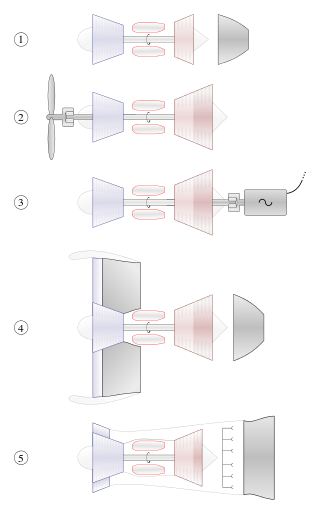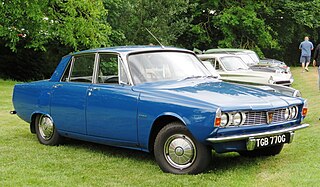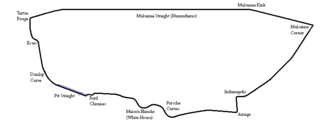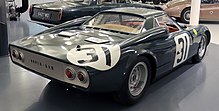
A gas turbine, also called a combustion turbine, is a type of continuous flow internal combustion engine. The main parts common to all gas turbine engines form the power-producing part and are, in the direction of flow:

The Lotus Elite name has been used for two production vehicles and one concept vehicle developed and manufactured by British automobile manufacturer Lotus Cars. The first generation Elite Type 14 was produced from 1957 until 1963 and the second generation model from 1974 until 1982. The Elite name was also applied to a concept vehicle unveiled in 2010.

The Rover Company Limited was a British car manufacturing company that operated from its base in Solihull in Warwickshire. Its lasting reputation for quality and performance was such that its first postwar model reviewed by Road & Track in 1952 was pronounced finer than any but a Rolls-Royce. Rover also manufactured the Land Rover series from 1948 onwards, which spawned the Range Rover in 1970, and went on to become its most successful and profitable product — with Land Rover eventually becoming a separate company and brand in its own right.

The Porsche 804 is a single-seat, open-wheeled racing car produced by Porsche to compete in Formula One (F1). It raced for a single season in 1962 in the 1½ litre formula.

British Racing Motors (BRM) was a British Formula One motor racing team. Founded in 1945 and based in the market town of Bourne in Lincolnshire, it participated from 1951 to 1977, competing in 197 grands prix and winning seventeen. BRM won the constructors' title in 1962 when its driver Graham Hill became world champion. In 1963, 1964, 1965 and 1971, BRM came second in the constructors' competition.

The Rover P6 series was a saloon car produced by Rover and subsequently British Leyland from 1963 to 1977 in Solihull, Warwickshire, England, UK.

The Rover P4 series is a group of mid-size luxury saloon cars produced by the Rover Company from 1949 until 1964. They were designed by Gordon Bashford.

The Peerless was a British car made by Peerless Cars Ltd. of Slough, Berkshire, between 1957 and 1960, when the company failed. The company was resurrected by one of the original founders, Bernie Rodger, as Bernard Roger Developments BRD Ltd and marketed as the Warwick from a base in Colnbrook, Buckinghamshire, between 1960 and 1962.

The 1972 24 Hours of Le Mans was a motor race staged at the Circuit de la Sarthe, Le Mans, France on 10 and 11 June 1972. It was the 40th running of the 24 Hours of Le Mans and the ninth race of the 1972 World Championship for Makes.

The 1965 24 Hours of Le Mans was the 33rd Grand Prix of Endurance, and took place on 19 and 20 June 1965. It was also the twelfth round of the World Sportscar Championship.

The 1964 24 Hours of Le Mans was the 32nd Grand Prix of Endurance, and took place on 20 and 21 June 1964. It was also the ninth round of the 1964 World Sportscar Championship season.

The 1963 24 Hours of Le Mans was the 31st Grand Prix of Endurance in the 24 Hours of Le Mans series and took place on 15 and 16 June 1963. It was also the tenth round of the 1963 World Sportscar Championship season.

The 1961 24 Hours of Le Mans was a motor race for Sports cars and Grand Touring cars staged at the Circuit de la Sarthe, Le Mans, France on 10 and 11 June 1961. It was the 29th Grand Prix of Endurance and the fourth race of the 1961 World Sportscar Championship. Ferrari and Maserati were the main contenders, with Aston Martin an outside chance.

The 1960 24 Hours of Le Mans was the 28th 24 Hours of Le Mans Grand Prix of Endurance, and took place on 25 and 26 June 1960, on Circuit de la Sarthe. It was the fifth and final round of the F.I.A. World Sports Car Championship as well as being the fifth round of the inaugural FIA GT Cup. It was held just a week after the tragic Belgian F1 GP in which four drivers, including Stirling Moss were either killed or seriously injured. The prospect of a duel between the 3-litre (180 cu in) Ferrari versus the 2-litre (120 cu in) Porsche championship-leaders was enough to draw large crowds to the 24 Hours race and some 200,000 spectators had gathered for Europe's classic sports car race, around the 13.5 km (8.4 mi) course.
The General Motors Firebird comprises a quartet of prototype cars that General Motors (GM) engineered for the 1953, 1956, and 1959 Motorama auto shows. The cars' designers, headed by Harley Earl, took Earl's inspiration from the innovations in fighter aircraft design at the time. General Motors never intended the cars for production, but rather to showcase the extremes in technology and design that the company was able to achieve.

The Aston Martin DP212 was a prototype sports car developed by Aston Martin for use in the 1962 24 Hours of Le Mans.

The Bristol 450 was a successful sports car racing prototype model, designed in 1953 by Bristol Cars and based on the abortive ERA G-type Formula Two car of 1952. Although most sources state that only three 450s were built, photographic evidence suggests that at least four were in existence at one point in time. The cars were constructed specifically to contest the prestigious 24 Hours of Le Mans endurance race, at which they won both their class and the team prize in both 1954 and 1955. In addition to its race victories, the Bristol 450 also took a number of outright speed records for the 2-litre class during trials at the Montlhéry circuit in 1953. Following the 1955 Le Mans disaster, which killed Pierre Levegh and 83 spectators, Bristol withdrew from direct involvement in motorsport and all but one of the 450s were broken up.

The Howmet TX was an American sports prototype racing car designed in 1968 to test the competitive use of a gas turbine engine in sports car racing. Planned by racing driver Ray Heppenstall, the TX combined a chassis built by McKee Engineering, turbine engines leased from Continental Aviation & Engineering, and financial backing and materials from the Howmet Corporation.

The BRM P57 was a Formula One racing car built to race in Formula One from 1962 to 1965.
The Leyland 2S gas turbine was developed by British Leyland to power road vehicles. The original version, the 2S/150 was famous for its use in a series of racing cars in the 1960s. In 1968, the basic layout was used to develop the larger 2S/350 for use in semi-trailers. The 2S/350 was also used in the British Rail APT-E train. Both were used only experimentally, development ended in the 1970s.

















